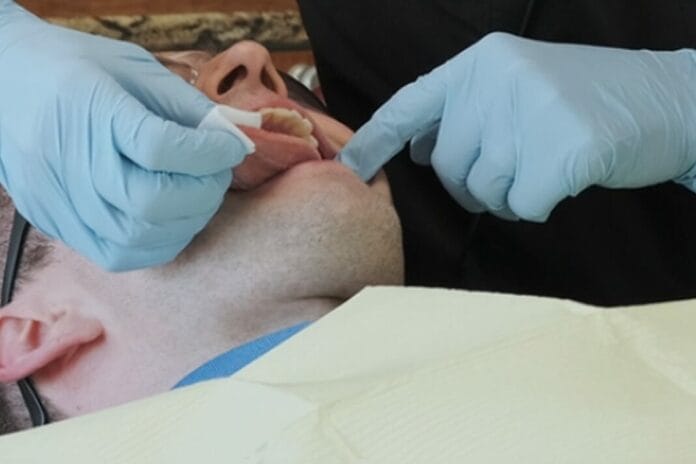Are you in need of CE credits? If so, check out our peer-reviewed, self-study CE courses here.
Test Your Oral Cancer Screening Knowledge
1. What percentage of Americans receive an oral cancer examination?
Individuals at higher risk tend to see their physicians more often than their dentists. While physicians are more inclined to offer advice on risk factors, like tobacco cessation, they are not as likely as dental clinicians to conduct examinations for oral cancer. Overall, only about 20% of Americans receive screenings for oral cancer.1
Reference
1. Oral Cavity and Nasopharyngeal Cancers Screening (PDQ) – Health Professional Version. (2024, April 12). National Cancer Institute. https://www.cancer.gov/types/head-and-neck/hp/oral-screening-pdq
2. A comprehensive head and neck cancer exam includes visual and tactile extraoral and intraoral assessments. Because the skin extends beyond the head and neck region, examining the skin during an extraoral exam of the head and neck is unnecessary.
A comprehensive head and neck cancer exam should include both visual and tactile intraoral and extraoral assessments. An extraoral clinical assessment includes an overall evaluation of the patient's general characteristics and a thorough evaluation of the head and neck structures, including the skin.1
An overview of the structures to assess include:2
- Face
- Eyes
- Nose
- Ears
- Skin
- Lymph nodes
- Oral cavity
- Lips
- Buccal and labial mucosa
- Vestibule
- Gingiva
- Salivary glands
- Tongue
- Hard palate
- Floor of the mouth
- Oropharynx
- Soft palate
- Tonsils
- Posterior pharyngeal wall
- Base of the tongue
- Neck
- Thyroid
- Lymph nodes
- Nasopharynx
- Hypopharynx
- Larynx
References
1. Fehrenbach, M.J. (2020). Extraoral and Intraoral Clinical Assessment. In J. A. Pieren & D. M. Bowen, Darby and Walsh Dental Hygiene (5th ed., pp. 195-222). Saunders.
2. Cancer Screening Protocols. (n.d.). Oral Cancer Foundation. https://oralcancerfoundation.org/discovery-diagnosis/cancer-screening-protocols/
3. Which of the following is not a common area for oral cavity cancer to develop?
Though cancer can develop anywhere in the oral cavity and oropharynx, cancers of the hard palate are uncommon in the U.S. The most common sites for oral cavity cancers include the tongue, floor of the mouth, and gingiva. The base of the tongue, oropharynx, tonsils, tonsillar pillars, and tonsillar crypt are common sites for oropharyngeal cancers, particularly in young, non-smoking individuals.1
Reference
1. Oral Cancer Facts. (n.d.). Oral Cancer Foundation. https://oralcancerfoundation.org/facts/
4. Dental clinicians only need to conduct an oral cancer examination at every appointment for patients with risk factors for oral cavity and oropharyngeal cancer.
Reviewing a patient's medical, dental, and social history and performing a thorough head and neck examination and cancer screening should be a routine part of each adult dental patient's appointment. However, clinicians should be extra vigilant in screening patients with risk factors, such as those who heavily use alcohol, tobacco, or both.1
More than 80% of oral cavity and oropharyngeal cancers are squamous cell carcinomas. Various risk factors for squamous cell carcinoma include:1,2
- Increasing age
- Tobacco use
- Alcohol use
- Heavy use of tobacco and alcohol together
- Chewing betel quid
- Immunosuppression
- Poor diet
- History of potentially malignant or malignant disorders
- Certain inherited diseases, such as Fanconi anemia
- HPV infection (a risk factor for oropharyngeal cancers specifically)
References
1. Cancer (Head and Neck). (2022, September 30). American Dental Association. https://www.ada.org/resources/ada-library/oral-health-topics/cancer-head-and-neck/
2. Lingen, M.W., Abt, E., Agrawal, N., et al. Evidence-Based Clinical Practice Guideline for the Evaluation of Potentially Malignant Disorders in the Oral Cavity: A Report of the American Dental Association. JADA. 2017; 148(10): 712-727. https://jada.ada.org/article/S0002-8177(17)30701-8/fulltext
5. What procedure is recognized as the gold standard for the definitive diagnosis of oral cancer?
Approximately 70% of oral cancer cases are diagnosed at a late stage, making clinical identification of any type of mucosal or submucosal abnormality at an early stage and coming to a subsequent definitive diagnosis vital in reducing disease-related morbidity and mortality. Visual and tactile examination partnered with a surgical biopsy and histopathological examination is recognized as the gold standard for the definitive diagnosis of oral cancer. Adult patients who present with a suspicious lesion should have a biopsy performed immediately.1
Reference
1. Lingen, M.W., Abt, E., Agrawal, N., et al. Evidence-Based Clinical Practice Guideline for the Evaluation of Potentially Malignant Disorders in the Oral Cavity: A Report of the American Dental Association. JADA. 2017; 148(10): 712-727. https://jada.ada.org/article/S0002-8177(17)30701-8/fulltext












